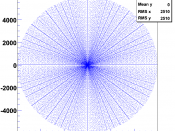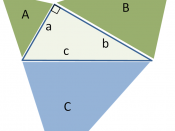My formulas are
1.2n + 1
2.2n2 + 2n
3.2n2 + 2n + 1
4.4n2 + 6n + 2
5.2n3 + 3n2 + n
To get these formulas I did the following
1.Take side 'a' for the first five terms 3, 5, 7, 9, 11. From these numbers you can see that the formula is 2n + 1 because these are consecutive odd numbers (2n + 1 is the general formula for consecutive odd numbers) You may be able to see the formula if you draw a graph
2.From looking at my table of results, I noticed that 'an + n = b'. So I took my formula for 'a' (2n + 1) multiplied it by 'n' to get '2n2 + n'. I then added my other 'n' to get '2n2 + 2n'. This is a parabola as you can see from the equation and also the graph
3.Side 'c' is just the formula for side 'b' +1
4.The perimeter = a + b + c. Therefore I took my formula for 'a' (2n + 1), my formula for 'b' (2n2 + 2n) and my formula for 'c' (2n2 + 2n + 1). I then did the following: -
2n + 1 + 2n2 + 2n + 2n2 + 2n + 1 = perimeter
Rearranges to equal
4n2 + 6n + 2 = perimeter
5.The area = (a x b) divided by 2. Therefore I took my formula for 'a' (2n + 1) and my formula for 'b' (2n2 + 2n). I then did the following: -
(2n + 1)(2n2 + 2n) = area
2
Multiply this out to get
4n3 + 6n2 + 2n = area
2
Then divide 4n3 + 6n2 + 2n by 2 to get
2n3 + 3n2 + n
To prove my formulas for 'a', 'b' and 'c' are correct. I decided incorporate my formulas into a2 + b2 = c2: -
a2 + b2= c2
(2n + 1)2+ (2n2 + 2n)2= (2n2 + 2n + 1)2
(2n + 1)(2n + 1) + (2n2 + 2n)(2n2 + 2n) = (2n2 + 2n + 1)(2n2 + 2n + 1)
4n2 + 2n + 2n + 1 + 4n4 + 4n2 + 4n3 + 4n3= 4n4 + 8n3 + 8n2 + 4n + 1
4n2 + 4n + 1 + 4n4 + 8n3 + 4n2= 4n4 + 8n3 + 8n2 + 4n + 1
4n4 + 8n3 + 8n2 + 4n + 1 = 4n4 + 8n3 + 8n2 + 4n + 1
This proves that my 'a', 'b' and 'c' formulas are correct
Extension
Polynomials
Here are the formulas for the perimeter and the area
Perimeter = 4n2 + 6n + 2
Area = 2n3 + 3n2 + n
From my table of results I know that the perimeter = area at term number 2. Therefore
(n-2) is my factor
I would like to find out at what other places (if any) the perimeter is equal to the area
To find this out I have been to the library and looked at some A-level textbooks and learnt 'Polynomials'
4n2 + 6n + 2 = 2n3 + 3n2 + n
6n + 2 = 2n3 - n2 + n
2 = 2n3 - n2 - 5n
0 = 2n3 - n2 - 5n - 2
2n2 + 3n + 1 b
n - 2 ) 2n3 - n2 - 5n - 2
2n3 - 4n2 b
3n2 - 5n - 2
3n2 - 6n b
n - 2
n - 2 b
0
This tells us that the only term where the perimeter = area is term number 2
Therefore when f(x) = 2n3 - n2 - 5n - 2 is divided by n - 2 there is no remainder and a quotient 2n2 + 3n + 1. The result can be written as
f(x) = 2n3 - n2 - 5n - 2= (n - 2)(2n2 + 3n + 1)
If 2 was substituted for the x in this identity so that n - 2 = 0, the quotient is eliminated giving f (2) = + 2
Now I will complete the square on '4n2 + 6n + 2' to see what the solution to this is.
4n2 + 6n + 2
4(n +3)2 - 9 + 2
4(n +3)2 - 7
4(n +3)2 = 7
(n +3)2 = 1.75
n + 3 = 1.322875656
n + 3 = -1.322875656
n = -1.677124344
n = -4.322875656
Arithmatic Progression
I would like to know whether or not the Pythagorean triple 3,4,5 is the basis of all triples just some of them.
To find this out I have been to the library and looked at some A-level textbooks and learnt 'Arithmatic Progression'
3, 4, 5 is a Pythagorean triple
The pattern is plus one
If a = 3 and d = difference (which is +1) then
3 = a
4 = a + d
5 = a +2d
a, a +d, a + 2d
Therefore if you incorporate this into Pythagoras theorem
a2 + (a + d)2 = (a + 2d)2
a2 + (a + d)(a + d) = (a + 2d)2
a2 + a2 + ad + ad + d2 = (a + 2d)2
2a2 + 2ad + d2 = (a + 2d)2
2a2 + 2ad + d2 = (a + 2d)(a + 2d)
2a2 + 2ad + d2 = a2 + 2ad + 2ad + 4d2
2a2 + 2ad + d2 = 4d2 + a2 + 4ad
If you equate these equations to 0 you get
a2 - 3d2 - 2ad = 0
Change a to x
x2 - 3d2 - 2dx = 0
Factorise this equation to get
(x + d)(x - 3d)
Therefore
x = -d
x = 3d
x = -d is impossible as you cannot have a negative dimension
a, a+d, a + 2d
Is the same as
3d, 4d, 5d
This tells us that the only Pythagorean triples are 3, 4, 5 or multiples of 3, 4, 5 e.g. 6, 8, 10 or 12, 16, 20 etc.



Helpful
This was really helpful, thanks alot!
1 out of 1 people found this comment useful.